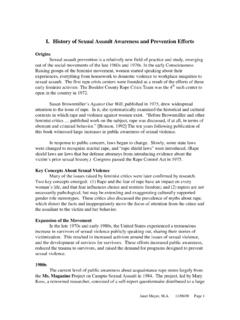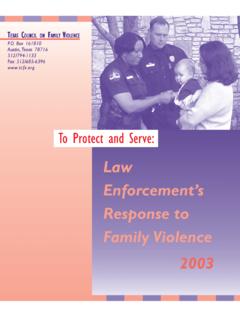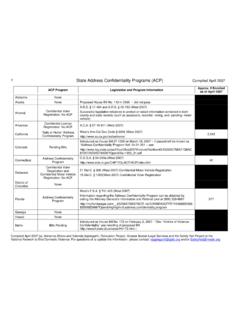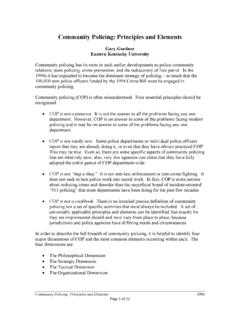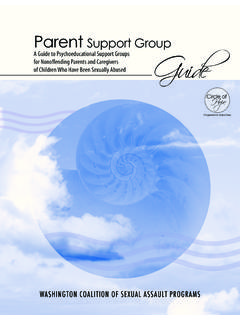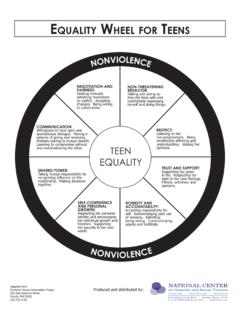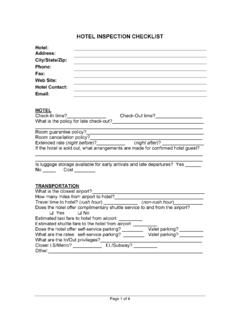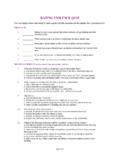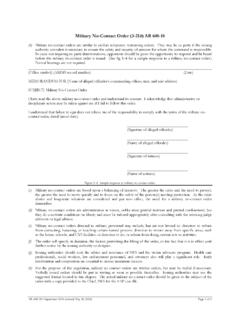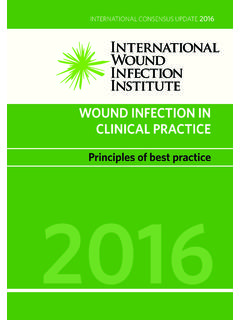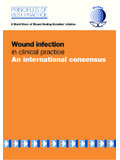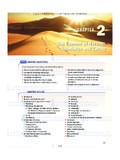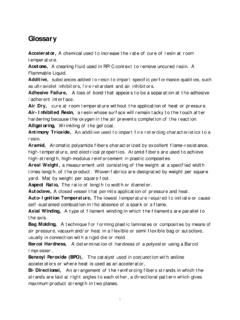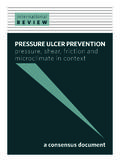Transcription of Army Regulation 608-18 THE FAMILY ADVOCACY …
1 Army Regulation 608-18 . THE FAMILY ADVOCACY PROGRAM. Abuse & Maltreatment terms Child abuse The physical or mental injury, sexual abuse or exploitation, or negligent treatment of a child. It does not include discipline administered by a parent or legal guardian to his or her child provided it is reasonable in manner and moderate in degree and otherwise does not constitute cruelty. Ref: Memo, USD (MC&FP), Subject: Domestic Violence and Child Abuse Fatality Reviews, February 12, 2004, Attachment 1. Child abuse/physical maltreatment Physical harm, mistreatment, or injury of a child by a parent, guardian, foster parent, or caregiver, whether the caregiver is intrafamilial or extrafamilial, under circumstances indicating that the child's welfare is harmed or threatened.
2 Such acts by a sibling, other FAMILY member, or other person will be deemed to be abuse or maltreatment only when the individual is providing care under express or implied agreement with the parent, guardian, or foster parent. Ref: Memo, ASD (FMP), Subject: Policy Changes for Submitting Child and Spouse Abuse Information, August 22, 1997, paragraph 9c(i). Child emotional maltreatment Acts or a pattern of acts, omissions or a pattern of omissions, or passive or passive-aggressive inattention to a child's emotional needs resulting in an adverse affect upon the child's psychological well-being. Maltreatment includes intentional berating, disparaging or other verbally abusive behavior toward the child, and violent acts that may not cause observable injury.
3 An emotionally maltreated child manifests low self-esteem, chronic fear or anxiety, conduct disorders, affective disorders, or other cognitive or mental impairment. Ref: Memo, ASD (FMP), Subject: Policy Changes for Submitting Child and Spouse Abuse Information, August 22, 1997, paragraph 9a. Child neglect A type of child abuse/maltreatment whereby a child is deprived of needed age-appropriate care by act or omission of the child's parent, guardian, or caregiver, an employee of a residential facility; or a staff person providing out-of home care under circumstances indicating that the child's welfare is harmed or threatened. Child neglect includes abandonment, deprivation of necessities, educational neglect, lack of supervision, medical neglect, and/or nonorganic failure to thrive.
4 Ref: Memo, ASD (FMP), Subject: Policy Changes for Submitting Child and Spouse Abuse Information, August 22, 1997, paragraph 9b. a. Abandonment. A type of child neglect in which the caregiver is absent and does not intend to return or is away from the home for an extended period without having arranged for an appropriate surrogate caregiver. Ref: Memo, ASD (FMP), Subject: Policy Changes for Submitting Child and Spouse Abuse Information, August 22, 1997, paragraph 9b(1). Army Regulation 608-18 , Personal Affairs, The FAMILY ADVOCACY Program Summary of Change, Abuse & Maltreatment terms , Headquarters, Department of the Army, Washington, DC, May 2006. Page 1 of 5. b.
5 Deprivation of necessities. A type of neglect that includes the failure to provide age-appropriate nourishment, shelter, and clothing. Ref: Memo, ASD (FMP), Subject: Policy Changes for Submitting Child and Spouse Abuse Information, August 22, 1997, paragraph 9b(2). c. Educational neglect. A type of child neglect that includes knowingly allowing the child to have extended or frequent absences from school, neglecting to enroll the child in some type of home schooling or public or private education, or preventing the child from attending school for other than justified reasons. Ref: Memo, ASD (FMP), Subject: Policy Changes for Submitting Child and Spouse Abuse Information, August 22, 1997, paragraph 9b(3).
6 D. Lack of supervision. A type of child neglect characterized by the absence or inattention of the parent, guardian, foster parent, or other caregiver that results in injury to the child, in the child being unable to care for himself or herself, or in injury or serious threat of injury to another person because the child's behavior was not properly monitored. Ref: Memo, ASD. (FMP), Subject: Policy Changes for Submitting Child and Spouse Abuse Information, August 22, 1997, paragraph 9b(4). e. Medical neglect. A type of neglect in which a parent or guardian refuses or fails to provide appropriate medically indicated health care (medical, mental health, or dental) for the child although the parent is financially able to do so or was offered other means to do so.
7 Ref: Memo, ASD (FMP), Subject: Policy Changes for Submitting Child and Spouse Abuse Information, August 22, 1997, paragraph 9b(5). f. Nonorganic failure to thrive. A type of child neglect that manifests itself in an infant's or young child's failure to adequately grow and develop when no organic basis for the deviation is found. Usually such children register below the third percentile in height and weight. Ref: Memo, ASD (FMP), Subject: Policy Changes for Submitting Child and Spouse Abuse Information, August 22, 1997, paragraph 9b(6). Child physical maltreatment Acts such as grabbing, pushing, holding, slapping, choking, punching, kicking, sitting or standing upon, lifting and throwing, burning, immersing in hot liquids or pouring hot liquids upon, hitting with an object (such as a belt or electrical cord), and assaulting with a knife, firearm, or other weapon that caused or may cause bodily injuries.
8 Such injuries include brain damage or skull fracture, subdural hemorrhage or hematoma, bone fracture, dislocations or sprains, internal injury, poisoning, burns or scalds, severe cuts, lacerations, bruises or welts. In infants and toddlers, abusive acts include shaking or twisting, which may cause brain damage, subdural hemorrhage, and hematoma. An injury does not have to be visible for physical maltreatment to be present. Ref: Memo, ASD (FMP), Subject: Policy Changes for Submitting Child and Spouse Abuse Information, August 22, 1997, paragraph 9c. Child sexual maltreatment Sexual activity with a child for the purpose of sexual gratification of the alleged offender or some other individual.
9 Ref: Memo, ASD (FMP), Subject: Policy Changes for Submitting Child and Spouse Abuse Information, August 22, 1997, paragraph 9d(i). a. Exploitation. A type of sexual maltreatment in which the victim is made to participate in the sexual gratification of another person without direct physical contact between them. Exploitation includes forcing or encouraging a child to do any of the following: to expose the child's genitals or (if female) breasts, to look at another individual's genitals or (if female). Army Regulation 608-18 , Personal Affairs, The FAMILY ADVOCACY Program Summary of Change, Abuse & Maltreatment terms , Headquarters, Department of the Army, Washington, DC, May 2006.
10 Page 2 of 5. breasts, to observe another's masturbatory activities, to view pornographic photographs or read pornographic literature, to hear sexually explicit speech, or to participate in sexual activity with another person, such as in pornography or prostitution, in which the alleged offender does not have direct physical contact with the child. Ref: Memo, ASD (FMP), Subject: Policy Changes for Submitting Child and Spouse Abuse Information, August 22, 1997, paragraph 9d(i)(1). b. Molestation. Fondling or stroking a child's breast or genitals, oral sex, or attempted penetration of the child's vagina or rectum. Ref: Memo, ASD (FMP), Subject: Policy Changes for Submitting Child and Spouse Abuse Information, August 22, 1997, paragraph 9d(i)(2).
